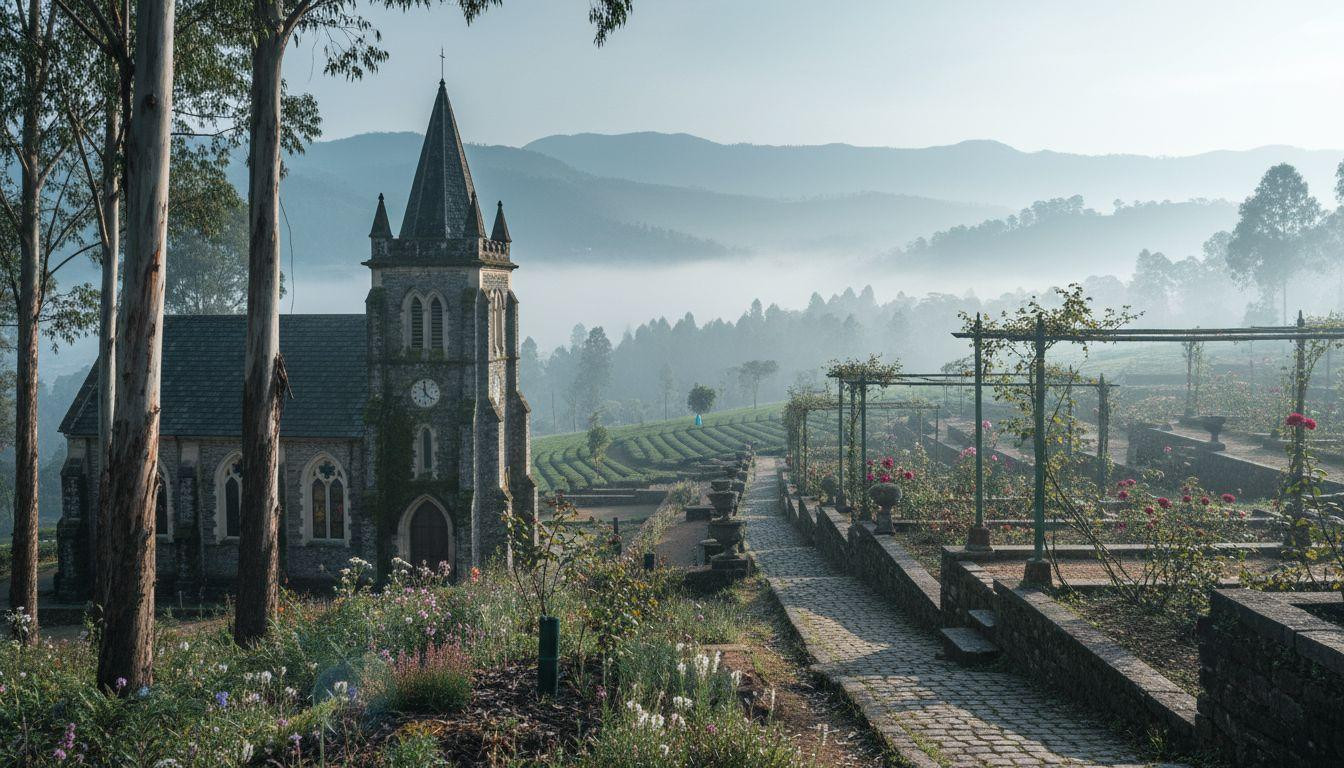Dawn breaks at 6:30 AM over the Nilgiri Hills as morning mist transforms tea estates into layers of emerald shadow. Seven colonial moments across Ooty (Udhagamandalam) redefine what an Indian hill station can offer. At 7,350 feet above sea level, this UNESCO World Heritage destination delivers experiences that rival Swiss Alps at 70% lower cost.
November 2025 marks peak season’s gentle beginning. Morning temperatures hover at 50-55°F while afternoons reach comfortable 66-82°F. The timing offers post-monsoon freshness without December holiday crowds.
1. UNESCO toy train journey through colonial engineering
The Nilgiri Mountain Railway, built by British engineers in 1908, climbs 46 miles through 208 curves and 16 tunnels. This narrow-gauge marvel ascends from Mettupalayam at 1,066 feet to Ooty at 7,228 feet in 4 hours 50 minutes.
Steam locomotives pull blue and cream coaches past tea pickers working geometric hillside patterns. Windows open to eucalyptus-scented air and valley views that emerge from morning mist. The journey costs approximately $6-18 depending on class selection.
Station names echo colonial heritage: Wellington, Lovedale, Coonoor. Each stop preserves 1900s architecture with period signage and hand-operated switching systems. This colonial hill station where a UNESCO toy train climbs through 20,000 rose varieties at 7,350 feet offers complementary rail heritage experiences.
2. Government botanical garden’s Victorian terraced splendor
Established in 1848, the 22-hectare botanical garden showcases colonial horticultural ambition. British botanists created terraced displays combining Nilgiri native species with imported European varieties. Entry costs $0.60-1.20.
Rose varieties numbering 20,000 specimens
November brings peak blooming season across geometric rose beds. Victorian-era pergolas frame pathways between Italian gardens and specialized ferneries. A fossilized tree trunk, 20 million years old, anchors the historical collection.
Temperature-controlled microclimates supporting global flora
Morning temperatures drop 5-7°F in shaded garden sections. This natural cooling supports temperate plants impossible to grow in lowland India. Conservatory houses protect subtropical species through cool mountain nights.
3. Fernhills Palace revealing royal colonial adaptation
Built in 1844 as Captain F. Cotton’s residence, Fernhills Palace became the Maharaja of Mysore’s summer retreat. Swiss chalet architecture blends carved wooden details with Indian palatial scale across 50 acres of landscaped grounds.
Heritage hotel operations preserving authentic interiors
Original teak furniture fills rooms where British officials and Indian royalty negotiated colonial administration. Rates range $150-400 nightly for heritage accommodation. Morning tea service includes Nilgiri muscatel varieties grown on surrounding estates.
Garden terraces overlooking tea plantation valleys
Palace grounds cascade down mountainsides through formal English gardens. Viewpoints frame distant Western Ghats peaks across emerald tea cultivation. This colonial hill station where British summer palaces rest above pine forests at 7,238 feet provides architectural comparisons with Shimla’s imperial legacy.
4. Stone House and botanical research foundations
Stone House served as residence for the first Government Botanical Garden superintendent. This colonial structure represents British scientific interest in cataloging Nilgiri flora for economic and aesthetic purposes. The building now houses botanical research archives.
Victorian-era documentation reveals systematic plant collection across the Western Ghats. Colonial botanists identified 2,500+ species for cultivation throughout the British Empire. Research continues supporting current conservation efforts in the Nilgiri Biosphere Reserve.
5. St. Stephen’s Church anchoring colonial spiritual life
Gothic revival architecture distinguishes St. Stephen’s Church as Ooty’s oldest Christian structure. Stone construction withstands mountain weather while stained glass windows filter colored light across wooden pews installed during the 1800s.
Church records document baptisms, marriages, and funerals of British officials, tea planters, and military personnel stationed in the Nilgiris. Services continue in English and Tamil, reflecting cultural continuity across colonial and independence periods.
6. Nilgiri Library’s 30,000-volume colonial collection
Founded in 1858, the Nilgiri Library houses British journals, administrative records, and travel accounts from the 19th century. Gothic architectural details frame reading rooms where European settlers gathered for intellectual exchange.
The collection includes 5,000 travel-related texts documenting colonial-era exploration across India and Southeast Asia. Reading room access costs minimal fees while supporting ongoing preservation of historical documents.
7 Highland beaches where white sand rivals Caribbean turquoise at 70% less cost offers Scottish Highland experiences with similar misty mountain atmospheres.
7. Adam’s Fountain marking colonial urban planning
Located at Charring Cross, Adam’s Fountain represents 19th-century municipal planning where three major roads converge. This central landmark served colonial administrators organizing hill station infrastructure and continues guiding modern navigation.
The fountain’s placement reflects British urban design principles adapted to mountain topography. Walking tours begin here for exploring colonial architecture throughout Ooty’s residential districts. Period street lamps and cobblestone sections preserve historical streetscapes.
7 eucalyptus moments across the Blue Mountains that redefine Australian wilderness 85 miles from Sydney provides comparable mountain experiences with botanical richness and mist-covered mornings.
Your questions about Ooty (Udhagamandalam), India answered
What’s the best time to visit Ooty for colonial architecture photography?
November through March offers ideal conditions with morning mist clearing by 9-10 AM and afternoon temperatures reaching comfortable 66-82°F. Soft morning light between 7-9 AM provides optimal illumination for stone buildings and Victorian details. November specifically avoids December holiday crowds while maintaining peak season weather reliability.
How does Ooty compare to other Indian hill stations?
Ooty sits at 7,350 feet elevation compared to Shimla’s 7,238 feet but offers year-round accessibility without winter closures. Tea plantation experiences distinguish Ooty from northern hill stations, while colonial architecture density rivals Darjeeling. Costs average 40-60% lower than international mountain destinations with comparable heritage value.
What transportation options connect colonial sites efficiently?
Auto-rickshaws cost $2.40-4.80 for local trips between colonial landmarks within town center. Full-day taxi hire ranges $24-36 covering Fernhills Palace, botanical gardens, and church sites. Walking tours cover central colonial architecture in 2-3 hours. The toy train provides scenic transportation but requires advance booking 10-14 days ahead.
Morning mist returns to Ooty’s colonial lanes as afternoon light fades behind eucalyptus groves. These seven moments transform tourist snapshots into lived colonial history. At $60-120 daily, mountain heritage awaits without European price tags.
